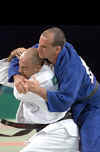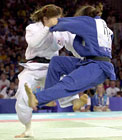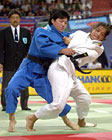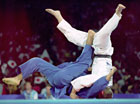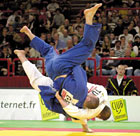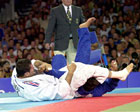|
Field
of play - The mat
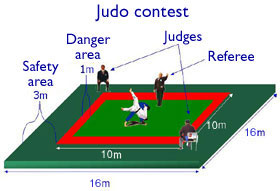
A Judo contest is conducted on a square 10 m x
10 m mat (Tatami).
There is a 1 m x 1 m danger area and a 3 - 4 m
outer safety area. The colour of the mat varies.
Green is usually preferred for the competition
and safety zone areas and red for the danger
area.
The
Contest
The
International Judo Federations’ regulations
apply to Paralympic Judo competition. One of the
main differences between Paralympic and Olympic
Judo is that in Paralympic Judo are allowed to
come into contact with their opponent, prior to
the beginning of the match. The referee signals
the start of the game, after the athletes grab
their opponent’s judogi (uniform).
To
win the contest a judoka must score an Ippon
(a degree equalling 10 points) by using a
successful technique. Lesser scores such as waza-ari
(7 points), yuko
(5 points) and koka
(3 points), can be awarded when a technique does
not warrant an Ippon. Athletes may also receive
penalties of corresponding points: hansoku
make (Ippon),
keikoku
(waza-ari), chui
(yuko) and shido
(koka).
Two
waza-ari add up to an Ippon. This also applies
if one competitor has already scored waza-ari
and the opponent is subsequently given a penalty
of keikoku. Yuko and koka do not add up. The
athlete who has gained more points at the
completion of the five minutes is the winner.
An
Ippon is given to the athlete who manages to
throw his opponent on his back with a technique
combining speed, force and control.
A waza-ari is awarded to an athlete when the
referee and judges consider an element of the
Ippon to be missing. This may be the case if the
opponent does not fall on his/her back or that
the athlete has not demonstrated enough force.
A yuko is awarded when two of the required
elements are missing. This may be the case when
the opponent falls on his/her side.
A kοkα awarded when three of the
required elements are missing. This may be the
case when the opponent falls on his/her shoulder
or leg.
An
Ippon is also awarded, when an athlete applies
an osaekomi technique and manages to hold
his/her opponent to the ground for 25 sec. The
referee calls the beginning and the end of the
osaekomi countdown.
Waza-ari is awarded when the opponent is unable
to escape for more than 20, but less than 25
seconds.
Yuko is awarded when the opponent is unable to
escape for more than 15, but less than 20
seconds.
Koka is awarded when the opponent is unable to
escape for more than 10, but less than 15
seconds.
An
Ippon is finally awarded to an athlete who
applies a strangling or joint technique and
thereby forces his/her opponent to give up by
tapping twice or more with his/her hand, or
says “maitta”
(I give up).
Categories
There
are seven categories for men and six for women,
in which visually impaired or blind athletes
compete:
|
Men
|
|
|
|
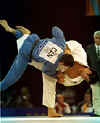
|
-60
Kg
-66 Kg
-73 Kg
-81 Kg
-90 Kg
-100 Kg
+100 Kg
|
|
|
|
|
Women
|
|
|
|

|
-48
Kg
-52 Kg
-57 Kg
-63 Kg
-70 Kg
-78 Kg
|
Rules of conduct
Judo
has two main elements, the sporting skills of
attack and defense and the culture of the sport
through, which these skills are performed. The
moral code of Judo is politeness, courage,
sincerity, self-control, honour, modesty,
friendship and respect. In Judo competition, a
judoka can be disqualified for deliberately
hurting their opponent.
The bow
 Bowing
is the most visible of the rituals of Judo. In
competition, judokas bow to each other at the
beginning and end of the contest to show their
respect and courtesy to each other as opponents
and to the institution of Judo, which fosters
fair play. The bow is used because it is a
physical act of humility, gratitude and
appreciation. Bowing
is the most visible of the rituals of Judo. In
competition, judokas bow to each other at the
beginning and end of the contest to show their
respect and courtesy to each other as opponents
and to the institution of Judo, which fosters
fair play. The bow is used because it is a
physical act of humility, gratitude and
appreciation.
|







 Although
Although
 “When
a stronger man pushes me with all his might, I will be beaten if
I simply go against him. If, instead of opposing his pushing I
retreat more then he pushes or turn aside the direction of his
pushing, he naturally leans forward through his own pushing and
loses his balance, and if utilizing his pushing strength I apply
a certain technique on him, it is quite possible to make him
fall, as he is losing his balance. Sometimes he will fall merely
if I turn my body skillfully. This is one simple instance of
how, by giving way, a contestant may defeat his opponent. There
in lies the principle of gentleness”.
“When
a stronger man pushes me with all his might, I will be beaten if
I simply go against him. If, instead of opposing his pushing I
retreat more then he pushes or turn aside the direction of his
pushing, he naturally leans forward through his own pushing and
loses his balance, and if utilizing his pushing strength I apply
a certain technique on him, it is quite possible to make him
fall, as he is losing his balance. Sometimes he will fall merely
if I turn my body skillfully. This is one simple instance of
how, by giving way, a contestant may defeat his opponent. There
in lies the principle of gentleness”.
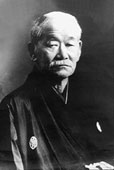 Jigoro
Kano was the one to introduce Judo in Japan, in
1882. Its techniques derived from martial arts
developed over centuries in various “Ju
jitsu” schools. Jigoro Kano devoted his life
to promoting the sport and training new athletes
and thereby created a legacy for today’s
generations.
Jigoro
Kano was the one to introduce Judo in Japan, in
1882. Its techniques derived from martial arts
developed over centuries in various “Ju
jitsu” schools. Jigoro Kano devoted his life
to promoting the sport and training new athletes
and thereby created a legacy for today’s
generations.




